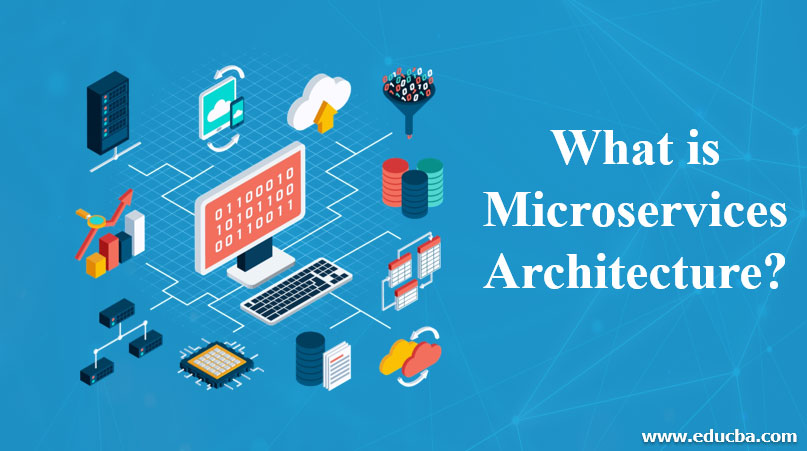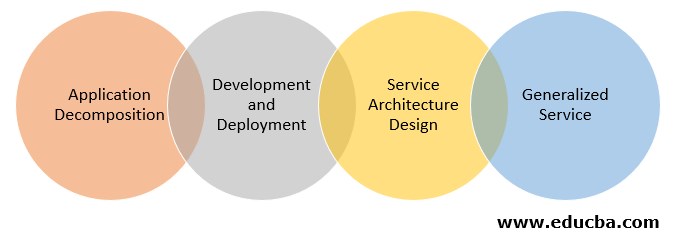What is Microservices Architecture?
Microservices, also called microservice architecture, is a style of architecture that designs an application as a set of Loosely coupled, Highly maintainable and testable, and independently deployable services. The microservice architecture provides the frequent, reliable, and fast delivery of complex applications.
Microservice Architecture in Nutshell
Microservice architecture is based on single responsibility and single services principle; it refers to combine each service that needs to be changed for the same reason(high cohesion) and separate the services which need to be changed for a different reason(loose coupling). Microservices architecture is based on this principle and scales the software application to the group of services that are loosely coupled and independent from each other, which can be developed, deployed, and maintained independently.
Each of these services is responsible for performing different business functions and can communicate with other’s services through simple APIs to provide a solution for large business enterprises. These services are responsible for the specific assigned task and can communicate with other services through simple APIs and Message Queuing (Message Queueing) to solve a larger complex business problem.
Benefits of Microservices Architecture
- As the application based on this architecture, services are small/tiny, which can be developed by one or more small teams from the starting and separated by business functions, making it easier to scale up the development in terms of business requirements and effort if need to be.
- Once the services are developed, these group of microservice can also be deployed and containerized independently of each other, irrespective of the technology is being used in the service development and hence it’s easy to identify hot services (which is being accessed very frequently) and scale them independent as a whole application. Microservices also offer improved fault tolerance and isolation whereby in the case of an error in one service (in the case when any of the individual services stops functioning), the whole application (the group of microservices) doesn’t necessarily stop functioning/working. When the error/bug is fixed, it can be deployed only for the respective service instead of redeploying an entire application.
- Microservices architecture is making it easier to bring to the table and choose the technology stack for the service development (programming languages, databases, Message Queuing, etc.), which is best suited for the required business functionality (service) instead of being required to use and take a more standardized, single fits- customize the application in all approach or use the SOA based application using middleware communication.
How to Start with a Microservices Architecture?
We currently perceive that a microservices design can give some distinctive features and benefits over ancient monolithic architectures; currently, we should discuss by concerning the event of microservice design. Spring Cloud Foundry provides tools and open source library for application developers to quickly develop some of the common and most widely used patterns and application architecture in distributed systems such as microservice architecture; this architecture involves application properties version configuration management, service registry, and discovery (Eureka Registry), circuit breakers for fallback (fault-tolerance and isolation- Hystrix), dynamic routing gateway (Zuul-API-Gateway), service-based network-proxy, communication control bus, single time tokens, sessions, service cluster state(Spring boot actuators), service to service calls (Feign/Rest client) messaging queuing (Kafka and RabbitMQ), etc.
Coordination of distributed systems leads to boilerplate code/ patterns, and by using Spring, Cloud developers can quickly stand up services and applications that by eliminating those patterns. They will work well in any distributed environment, including the developer’s laptop, metal data centers, and managed platforms such as Spring Cloud Foundry service.
Spring Cloud focuses on providing good out of box experience for typical use cases of distributed architecture and microservice development by providing the dynamic service spring cloud library :
- Distributed/versioned configuration
- Service registration and discovery
- Routing
- service-to-service calls
- Load balancing
- Circuit Breakers
- cluster state monitoring
- Distributed messaging
Spring Cloud uses a declarative programming approach, and frequently you get plenty of options with simply a classpath amendment associate degree/or an annotation.
Procedure to Develop Microservice-Based Application
There are conceptual elements that relate to the various functional areas of the application.
Procedure to develop the microservice-based application are:
1. Application Decomposition
Before moving on to the development of the service, it requires a high-level understanding of business functions, requirements, and capabilities. A separate team can develop each service with expertise in that specific business function domain and an expert in the cutting-edge development technologies that are best suited for those particular services. This often leads to more stable development for microservice applications.
2. Development and Deployment
Service development technologies that are best suited for each purpose of business. For example, we might choose to build a User Service in Java with a Ms SQL database and a Product Recommendation Service with Scala/Python.
after the development of the service continuous integration and continuous delivery, pipelines is established with any of the available CI and CD servers (AWS CodePipeline, AWS cloud formation, Jenkins); by running the automated test cases on each build, we can ensure that there is no integration issue in code developed by other developers and we do not need to deploy a group of service together apart from it, this service can be deployed separately to different environments (Integration, QA (SIT and UAT), Staging) and production (live environment) according to the web traffic and service scalability.
3. Service Architecture Design
When designing the individual services, define the service architecture and consider factors such as what will be exposed in terms of input and output, what protocols will be used to interact with the service, the implementation of the service REST/SOAP, etc., persistence framework need to be used, interaction with other services and DB, we can use tools like enterprise architect for service design.
4. Generalized Service
There are product and service-based enterprises (online marketing, e-commerce, Intelligent business process systems, core/investment banking solution, etc.) which are succeeded with the microservices and follow a DevOps model for microservice development and deployment where the teams’ members who develop the application services take care of each and everything related to that application/service. There are no specific support or maintenance teams available for the services/application.
Conclusion
Till now, we had already discussed microservice development and deployment; why do we need to develop and deploy a microservices-based design (architecture) for enterprise business product it always depends on factors such as what is the business function, after considering all these factors, always prefer to with a start little by simply setting out to configure and develop microservices, initially begin with the development of very few services get the experience from them and develop more.
which architecture should adopt for the application development is always depends on the enterprise business functions and requirements. Monolithic architecture and Microservice architecture have their own significant advantages and disadvantages, which we should consider before selecting the development architecture.
Recommended Articles
This is a guide to What is Microservices Architecture? Here we discuss the introduction and benefits of microservices architecture along with the process to develop the microservice-based application. You may also look at the following articles to learn more –




